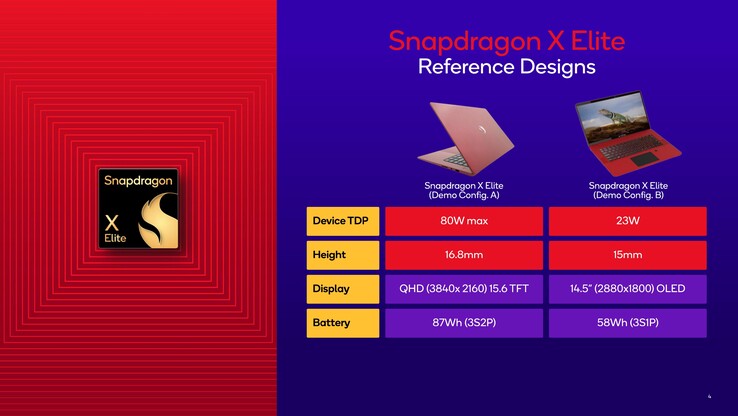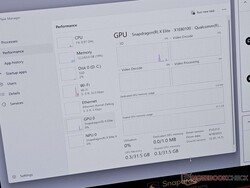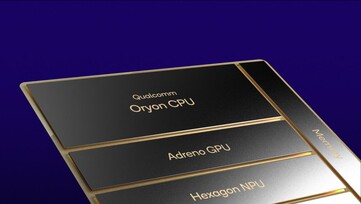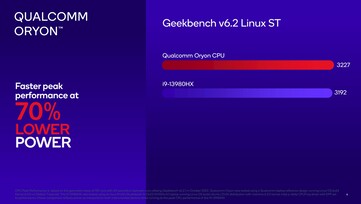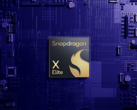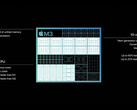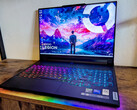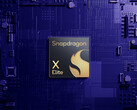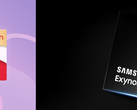Ever since Microsoft introduced Windows RT back in 2012, Windows on ARM couldn't really find the right launchpad and was mostly considered DoA. It took some time for WoA laptops to match up to market requirements, and even for Microsoft to introduce proper 64-bit emulation.
Apple MacBooks powered by fast M-series chips hogged all the limelight and while ARM Windows laptops, such as the Surface Pro 9, continue to be available, Qualcomm struggled to find proper ground.
All that changes for the better (hopefully) with the new Snapdragon X Elite SoC.
Snapdragon X Elite will be available in several TDP configs with potential dGPU support
Qualcomm's Director of Compute Product Management, Sriram Dixit, showed the X Elite's benchmark scores on two TDP configurations — Config A with 80 W max and Config B with 23 W. However, Qualcomm told us during the media session that OEMs can configure the Snapdragon X Elite's TDP according to their requirements.
OEMs can start from 12 W for fanless designs and possibly top out at 80 W. That being said, most X Elite offerings will be in the 45 W range. Additionally, OEMs can also customize the compute aspect of the Adreno GPU for their needs. Unfortunately, Qualcomm will not be officially sharing Adreno version numbers or clock speeds. Based on what we could gather, the first X Elite chips use an older Adreno GPU with no ray tracing support.
That being said, Qualcomm did not rule out the possibility of OEMs using discrete GPUs in combination with the X Elite. However, there is little probability of such configurations at least in the first wave of devices in 2024.
The X Elite uses ARM's 8.7 instruction set and its Adreno GPU offers full DirectX and OpenGL support, according to Qualcomm. Additionally, devices powered by the X Elite will offer 8 PCIe Gen4 lanes apart from those used for the SSD and Wi-Fi, support for MAPI cameras, and potentially multi-day battery life.
Snapdragon X Elite takes on Intel, AMD, and Apple flagships in single-core
Now, let's take a first look at reference performance numbers for the 80 W and 23 W X Elite configs. Right off the bat, we see that the Snapdragon X Elite 80 W and 23 W can actually take on an Intel Core i5-14600K in single-core Geekbench 6.2 tests. The 80 W X Elite leads the Apple M2 Max by 10% while the 23 W variant just manages to inch past Apple's leading ARM chip.
Both the AMD Ryzen 9 7940HS average and the Core i9-13900H average trail the 80 W X Elite by 12% in Geekbench 6.2 single-core.
Similarly, Cinebench 2024 single-core sees the X Elite 80 W right on the heels of the Core i9-14900K while the X Elite 23 W isn't too far behind. Thus, it is becoming increasingly clear that the Snapdragon X Elite's single-core performance can rival the best of current offerings from Intel, AMD, and Apple.
The Snapdragon X Elite offers 12 performance cores with a max dual-core boost of up to 4.3 GHz. There are no efficiency cores in this SoC. The 80 W Elite's multi-core performance in Geekbench 6.2 rivals that of the Apple M2 Max while the 23 W variant is within striking distance.
The X Elite's reliance on performance cores alone seems to confer even the 23 W variant with decent Geekbench 6.2 multi-core leads of 6% and 16% over much more powerful offerings such as the Core i9-13900H average and the Ryzen 9 7940HS average, respectively.
While Geekbench 6.2 multi-core shows only an 8% performance difference between the 80 W and 23 W X Elites, this delta widens to about 22% in Cinebench 2024 multi. Still, we see that the 23 W X Elite can lead the Ryzen 7 7840HS by 4% and the Core i7-13620H by 37%. With the 80 W X Elite, this lead can be as high as 77%.
| Geekbench 6.5 / Single-Core | |
| Average Intel Core i9-14900K (3108 - 3294, n=9) | |
| Average AMD Ryzen 9 7950X (2905 - 3083, n=21) | |
| SD X Elite Reference 80W | |
| Average Intel Core i5-14600K (n=1) | |
| SD X Elite Reference 23W | |
| Average Intel Core i7-13800H (n=1) | |
| Average Apple M2 Max (n=1) | |
| Average Apple M2 Pro 10-Core (n=1) | |
| Average Apple M2 Pro (n=1) | |
| Average AMD Ryzen 7 7840HS (2585 - 2721, n=21) | |
| Average Intel Core i9-13900H (2415 - 2807, n=14) | |
| Average AMD Ryzen 9 7940HS (2408 - 2746, n=10) | |
| Average Apple M2 (2587 - 2650, n=4) | |
| Average Intel Core i7-13620H (2498 - 2605, n=5) | |
| Snapdragon 8 Gen 3 Reference Design | |
| Geekbench 6.5 / Multi-Core | |
| Average Intel Core i9-14900K (20435 - 21790, n=9) | |
| Average AMD Ryzen 9 7950X (14900 - 21166, n=21) | |
| Average Intel Core i5-14600K (n=1) | |
| SD X Elite Reference 80W | |
| Average Apple M2 Max (n=1) | |
| Average Apple M2 Pro (n=1) | |
| SD X Elite Reference 23W | |
| Average AMD Ryzen 7 7840HS (11804 - 13538, n=21) | |
| Average Apple M2 Pro 10-Core (n=1) | |
| Average Intel Core i7-13800H (n=1) | |
| Average Intel Core i9-13900H (11118 - 14404, n=14) | |
| Average AMD Ryzen 9 7940HS (9798 - 13470, n=10) | |
| Average Intel Core i7-13620H (9131 - 13077, n=5) | |
| Average Apple M2 (10034 - 10120, n=4) | |
| Snapdragon 8 Gen 3 Reference Design | |
| Cinebench 2024 / CPU Single Core | |
| Average Intel Core i9-14900K (134 - 138, n=4) | |
| SD X Elite Reference 80W | |
| SD X Elite Reference 23W | |
| Average Apple M2 Pro (n=1) | |
| Average Intel Core i5-14600K (n=1) | |
| Average Apple M2 (n=1) | |
| Average Intel Core i7-13800H (n=1) | |
| Average AMD Ryzen 9 7950X (114 - 123, n=3) | |
| Average Intel Core i7-13620H (109 - 110, n=2) | |
| Average Intel Core i9-13900H (101 - 118.8, n=4) | |
| Average AMD Ryzen 9 7940HS (102.9 - 108, n=9) | |
| Average AMD Ryzen 7 7840HS (101 - 107, n=6) | |
| Cinebench 2024 / CPU Multi Core | |
| Average Intel Core i9-14900K (2112 - 2352, n=4) | |
| Average AMD Ryzen 9 7950X (1514 - 2063, n=3) | |
| Average Intel Core i5-14600K (n=1) | |
| SD X Elite Reference 80W | |
| Average Apple M2 Pro (n=1) | |
| Average Intel Core i7-13800H (n=1) | |
| SD X Elite Reference 23W | |
| Average AMD Ryzen 9 7940HS (824 - 972, n=9) | |
| Average AMD Ryzen 7 7840HS (868 - 956, n=6) | |
| Average Intel Core i9-13900H (680 - 962, n=4) | |
| Average Intel Core i7-13620H (691 - 824, n=2) | |
| Average Apple M2 (n=1) | |
Snapdragon X Elite Adreno GPU leads M2 but trails behind M2 Pro and M2 Max
Although Qualcomm said that the Snapdragon X Elite's Adreno GPU is fully compliant with DirectX, we observed that the test devices on display at the event showed support for only up to DirectX 12 Feature Level 11_1 (see adjoining image). This means capabilities such as ray tracing, variable rate shading, and mesh shaders that are only available with Feature Level 12_2 won't be available, at least not yet.
The Adreno GPU in the Snapdragon X Elite may lack some of the features like ray tracing that the Adreno 750 in the new 8 Gen 3 can offer, but it does seem to have a significant raw performance advantage in the GFXBench Aztec Ruins Normal Tier Offscreen test.
The 23 W X Elite's Adreno GPU leads the M2's GPU average by 6% while the 80 W variant shows a good 29% gain in this benchmark. However, both the X Elite variants take a beating against the M2 Pro average and M2 Max average GPUs.
| GFXBench / Aztec Ruins Normal Tier Offscreen | |
| Average Apple M2 Max (853 - 950, n=2) | |
| Average Apple M2 Pro (565 - 568, n=2) | |
| Average Apple M2 Pro 10-Core (n=1) | |
| SD X Elite Reference 80W | |
| SD X Elite Reference 23W | |
| Average Apple M2 (208 - 296, n=9) | |
| Snapdragon 8 Gen 3 Reference Design | |
| Average Intel Core i9-13900H (n=1) | |
| Average AMD Ryzen 9 7940HS (n=1) | |
Being a Windows platform, the natural question is how effective would Snapdragon X Elite-powered laptops be for gaming? Qualcomm didn't have a particular answer to this, except that it notes things will eventually depend on Microsoft to allow for decent emulation of popular Windows titles.
The company did indicate that they are pushing for native ARM games and showed off Control, Baldur's Gate 3, Farming Simulator 22, Minecraft, and other titles coming to the platform.
Qualcomm also demoed a non-ARM version of Davinci Resolve 18 that is able to leverage the X Elite's NPU to apply a Magic Mask 2x faster than the x86 version of the program. Davinci Resolve will offer a native ARM app for Windows in 2024.
Closing thoughts: Great potential on paper but needs proper execution
Overall, we see that the Snapdragon X Elite has excellent potential — one that the Windows on ARM platform has been sorely longing for all these years. However, benchmark numbers are only one part of the larger puzzle.
Laptops powered by the X Elite are expected to arrive only in 2024. Apple is expected to introduce the M3 SoC at tomorrow's Scary Fast event, which in all likelihood will further increase the performance gap with Qualcomm's offering.
Interestingly, Qualcomm alludes to "Windows OS" in the footnotes instead of specifying Windows 11. This indicates that Microsoft is indeed working on a proper Windows 12 release next year that would offer enhanced support for ARM SoCs.
Microsoft has to get its act together on the software side of things as one of the main reasons why Windows on ARM didn't quite take off was limited app support and the general notion, "if it's Windows, it should be able to run my favorite program from 20 years ago". Microsoft would do best to shed the legacy image of Windows with Windows on ARM vNext and improve compatibility with modern x64 and native ARM apps either via the Store or standalone installs.
All said and done, it is finally good to see Qualcomm stepping up its game. Hopefully, OEMs will offer compelling designs next year that can take on Apple's best.
Slides from the media briefing are embedded below.
Source(s)
Own





